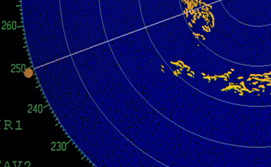Researchers from Madrid’s Carlos III University (UC3M) have developed a real application for maritime surveillance, which is able to integrate and unify the information coming from different types of sensors and contextual data.
The system has been designed by scientists from the Madrid university for Núcleo CC, a company that develops surveillance systems in the aeronautic and maritime sectors. The first prototype will soon be used in Cape Verde (Africa), where two types of sensors have been deployed: a group of radars and a series of AIS (Automatic Identification System) tracking stations. These permit vessels to communicate their position and other relevant data regarding their situation and characteristics. These two types of sensors provide complementary data that can be merged together, in order to have better information about what is taking place in relevant sea and coastal areas. This has been achieved by scientists from the Applied Artificial Intelligence Group (GIAA) of UC3M who developed this project, called “Information Fusion in Maritime Traffic”.
The result of this research, presented last July at the International Conference on Information Fusion held in Edinburgh (Scotland), has been the creation of a data fusion software that is able to perform better maritime surveillance, integrating simultaneously the capabilities of the radars and the AIS tracking stations deployed. The goal: guaranty the security of the area, monitoring the various ships that are circulating on a particular maritime route that is, at the same time, the entry to and exit from a commercial port. “In order to do this—points out one of the managers of the study, Jesús Garcia, of the Computer Science Department at UC3M—one must have a complete picture that is precise and up to date, similar to what is available to air traffic controllers, of all the ships that are in a coverage zone in order to be able to adequately manage maritime traffic and detect anomalies with as much advance notice as possible”.
 The current prototype is able to monitor 2,000 identifiable objects from large vessels to small boats, with the capacity to process data from up to 10 sensors and provide data exit with a refreshment period of one second. “Boats have to be located 24 hours a day, 7 days a week, 365 days a year, independently of failures with the sensors or the other different mechanisms involved and, in some way, what this systems tries to do is guaranty that this can be accomplished”, explains José Luis Guerrero of the UC3M’s Colmenarejo Campus, another of the researchers from GIAA working on this project. “In this way—he continues—we will never lose track of these boats, in order to avoid possible collisions or any type of problem in the management of information regarding the dynamics of movement of these vessels.”
The current prototype is able to monitor 2,000 identifiable objects from large vessels to small boats, with the capacity to process data from up to 10 sensors and provide data exit with a refreshment period of one second. “Boats have to be located 24 hours a day, 7 days a week, 365 days a year, independently of failures with the sensors or the other different mechanisms involved and, in some way, what this systems tries to do is guaranty that this can be accomplished”, explains José Luis Guerrero of the UC3M’s Colmenarejo Campus, another of the researchers from GIAA working on this project. “In this way—he continues—we will never lose track of these boats, in order to avoid possible collisions or any type of problem in the management of information regarding the dynamics of movement of these vessels.”